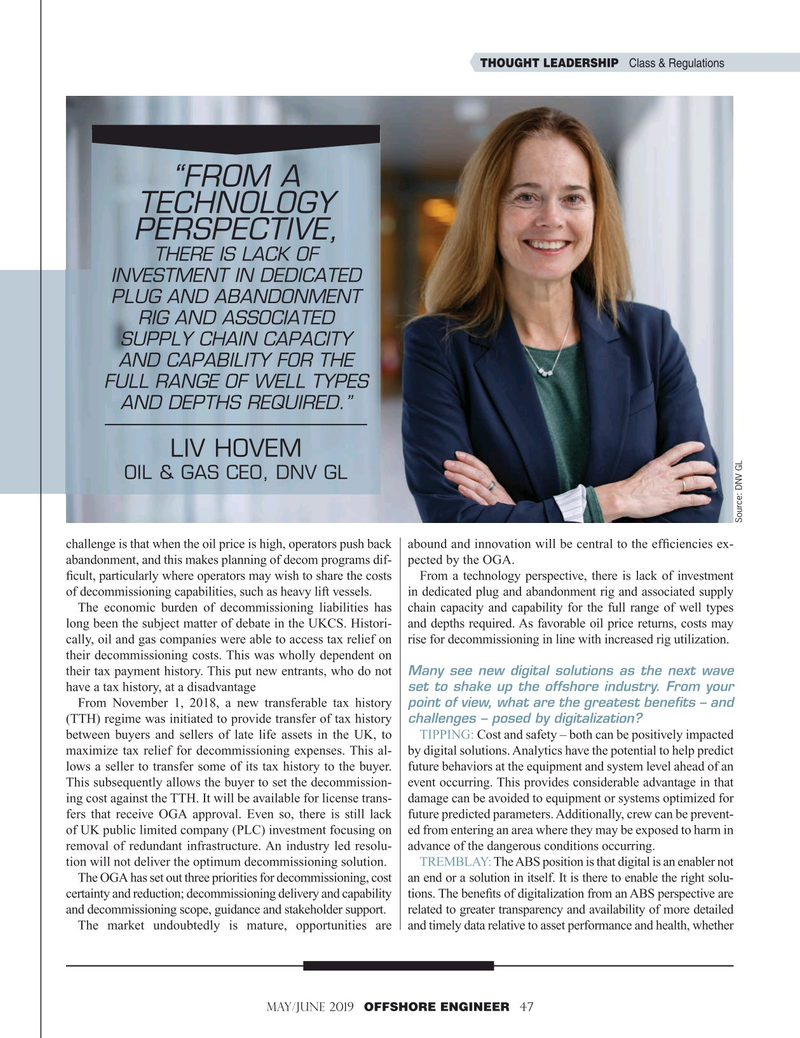
Page 47: of Offshore Engineer Magazine (May/Jun 2019)
Offshore Renewables Review
Read this page in Pdf, Flash or Html5 edition of May/Jun 2019 Offshore Engineer Magazine
THOUGHT LEADERSHIP Class & Regulations “FROM A
TECHNOLOGY
PERSPECTIVE,
THERE IS LACK OF
INVESTMENT IN DEDICATED
PLUG AND ABANDONMENT
RIG AND ASSOCIATED
SUPPLY CHAIN CAPACITY
AND CAPABILITY FOR THE
FULL RANGE OF WELL TYPES
AND DEPTHS REQUIRED.”
LIV HOVEM
OIL & GAS CEO, DNV GL
Source: DNV GL challenge is that when the oil price is high, operators push back abound and innovation will be central to the ef? ciencies ex- abandonment, and this makes planning of decom programs dif- pected by the OGA. ? cult, particularly where operators may wish to share the costs From a technology perspective, there is lack of investment of decommissioning capabilities, such as heavy lift vessels. in dedicated plug and abandonment rig and associated supply
The economic burden of decommissioning liabilities has chain capacity and capability for the full range of well types long been the subject matter of debate in the UKCS. Histori- and depths required. As favorable oil price returns, costs may cally, oil and gas companies were able to access tax relief on rise for decommissioning in line with increased rig utilization. their decommissioning costs. This was wholly dependent on their tax payment history. This put new entrants, who do not Many see new digital solutions as the next wave have a tax history, at a disadvantage set to shake up the offshore industry. From your
From November 1, 2018, a new transferable tax history point of view, what are the greatest benefits – and (TTH) regime was initiated to provide transfer of tax history challenges – posed by digitalization? between buyers and sellers of late life assets in the UK, to TIPPING: Cost and safety – both can be positively impacted maximize tax relief for decommissioning expenses. This al- by digital solutions. Analytics have the potential to help predict lows a seller to transfer some of its tax history to the buyer. future behaviors at the equipment and system level ahead of an
This subsequently allows the buyer to set the decommission- event occurring. This provides considerable advantage in that ing cost against the TTH. It will be available for license trans- damage can be avoided to equipment or systems optimized for fers that receive OGA approval. Even so, there is still lack future predicted parameters. Additionally, crew can be prevent- of UK public limited company (PLC) investment focusing on ed from entering an area where they may be exposed to harm in removal of redundant infrastructure. An industry led resolu- advance of the dangerous conditions occurring.
tion will not deliver the optimum decommissioning solution. TREMBLAY: The ABS position is that digital is an enabler not
The OGA has set out three priorities for decommissioning, cost an end or a solution in itself. It is there to enable the right solu- certainty and reduction; decommissioning delivery and capability tions. The bene? ts of digitalization from an ABS perspective are and decommissioning scope, guidance and stakeholder support. related to greater transparency and availability of more detailed
The market undoubtedly is mature, opportunities are and timely data relative to asset performance and health, whether
MaY/JUNE 2019 OFFSHORE ENGINEER 47

 46
46

 48
48